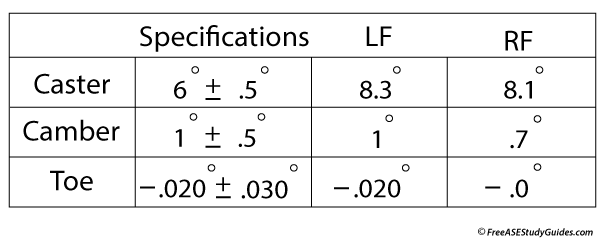ASE A4 Steering and Suspension Practice Test

51. The steering wheel on the vehicle in the alignment chart above snaps back to the center too quickly. The MOST likely cause of this condition is:
- A. Excessive toe-in.
- B. Excessive positive caster.
- C. Out-of-balance tires.
- D. Excessive negative camber.
52. The steering on a vehicle with a rack and pinion power steering system binds while making left-hand turns. Which of the following is MOST likely causing this condition?
- A. A worn ball joint.
- B. Loose tie rod ends.
- C. A binding universal joint coupling.
- D. A fractured tooth on the rack gear.
53. The back of a light truck with a solid rear axle and a coil-spring suspension is squeaking and making clunking noises. Which of the following is LEAST likely to cause this noise?
- A. The trailing control arm bushings.
- B. The rack and pinion mounting bushings.
- C. The leading control arm bushings.
- D. The track bar bushings.
54. The customer states that the TPMS warning light on the instrument panel remains on after startup and that after driving the vehicle for several miles, the light goes out. Which of the following is MOST likely causing this condition?
- A. Different-sized tires.
- B. A clogged TPMS sensor.
- C. The initialization process.
- D. Low tire air pressure.
55. A vehicle makes a clicking sound only when making turns. Which of the following is MOST likely causing this condition?
- A. A faulty inner tie rod end.
- B. A faulty outside CV axle joint.
- C. A faulty motor mount.
- D. A faulty outer tie rod end.